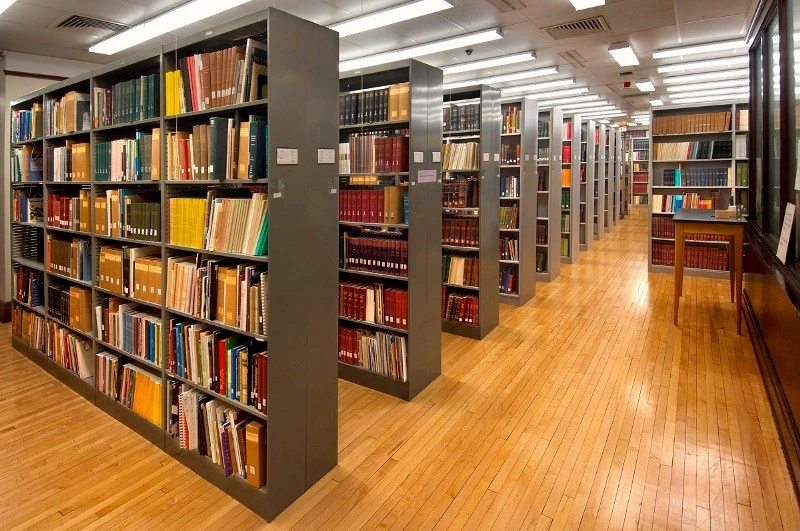
Welcome to our exploration of the fascinating world of libraries! These treasured institutions are more than just repositories of books; they are vibrant community hubs filled with knowledge, history, and culture. In this blog, we will uncover a variety of interesting facts about libraries that highlight their significance in society, their evolution over time, and the innovative ways they continue to serve us today. Whether you’re a lifelong book lover or just curious about what makes libraries so special, join us as we delve into the remarkable stories and surprising statistics that illustrate the enduring power of libraries in our lives.
The first known library was established in Nineveh, Assyria, around 668-627 BC. This library, often attributed to the Assyrian king Ashurbanipal, housed over 30,000 clay tablets inscribed with cuneiform script. These tablets contained a wealth of knowledge, including literature, administrative documents, and scientific texts, showcasing the advanced civilization of the Assyrians. The collection aimed to preserve and disseminate knowledge, making it a precursor to modern libraries.
The Library of Alexandria, founded in the 3rd century BC in Egypt, was one of the largest and most significant libraries of the ancient world. It was part of a larger research institution known as the Mouseion, dedicated to the Muses, the goddesses of the arts. The library is said to have housed hundreds of thousands of scrolls, covering subjects from philosophy to mathematics. Scholars from various cultures gathered here, making it a center for learning and intellectual exchange until its decline.
During the Middle Ages, monasteries played a crucial role in preserving books and manuscripts. Monks meticulously copied texts by hand, ensuring that classical works, religious scriptures, and scholarly writings were not lost to time. These monastic libraries became sanctuaries of knowledge, often containing unique collections that would influence the Renaissance. The dedication of these monks helped to maintain literacy and scholarship during a period often characterized by cultural stagnation.
The Bodleian Library at Oxford University, established in 1602, is one of the oldest libraries in Europe still in operation. It is renowned for its extensive collection, which includes over 13 million printed items, manuscripts, and maps. The library’s architecture is a blend of historic and modern styles, featuring the iconic Radcliffe Camera. It serves not only as a research library but also as a cultural hub, hosting exhibitions and events that celebrate literature and scholarship.
The first public library in the United States was the Boston Public Library, founded in 1848. This pioneering institution was established with the vision of providing free access to books for all citizens, regardless of their social status. The library’s beautiful main building, completed in 1895, features stunning murals and a grand reading room. It has since expanded its services to include digital resources, community programs, and outreach initiatives that promote literacy and education.
Many libraries now offer e-books and audiobooks, allowing patrons to borrow digital copies of their favorite titles. This shift to digital media has made reading more accessible, particularly for those who may have difficulty accessing physical books. Libraries partner with platforms such as OverDrive and Libby to provide these services, enabling users to borrow and enjoy a wide range of genres from the comfort of their homes using their devices.
Some libraries provide access to 3D printers, giving users the opportunity to create physical objects from digital designs. This innovative service allows patrons to engage in hands-on learning and creativity, whether for personal projects, educational purposes, or community initiatives. By offering workshops and training sessions, libraries help demystify technology and encourage exploration in fields like engineering, design, and art.
The Library of Congress, the largest library in the world, has over 170 million items in its collection, including books, recordings, photographs, maps, and manuscripts. Established in 1800, it serves as the research arm of the U.S. Congress and is a treasure trove of American history and culture. The library’s vast resources are available to the public, and it plays a vital role in preserving the nation’s heritage through various digitization initiatives and educational programs.
Many libraries offer free Wi-Fi and computer access, helping bridge the digital divide for those without internet at home. This service is crucial in today’s digital age, where online access is essential for job searching, education, and communication. By providing these resources, libraries empower individuals and communities, ensuring that everyone has the opportunity to connect and thrive in an increasingly digital world.
Some libraries have started lending out unconventional items like tools, musical instruments, and even seeds for gardening. This “Library of Things” concept encourages sharing and sustainability, allowing patrons to access items they may not want to purchase or store permanently. By promoting resource-sharing, libraries foster community engagement and creativity, providing opportunities for learning and exploration beyond traditional books.
The Bibliotheca Alexandrina in Egypt is a modern recreation of the ancient Library of Alexandria, with space for eight million books. Opened in 2002, it aims to revive the spirit of the original library as a center for learning and cultural dialogue. The stunning architecture, designed to resemble a rising sun, houses various facilities, including museums, exhibition spaces, and a planetarium, making it a vibrant cultural landmark.
The Tianjin Binhai Library in China features a stunning, futuristic design with floor-to-ceiling books shelves. Opened in 2017, this architectural marvel has quickly become a popular destination for both locals and tourists. The library’s unique design includes a large, spherical auditorium at its center, surrounded by cascading bookshelves that create a visually striking effect. With a collection that emphasizes accessibility and community engagement, the Tianjin Binhai Library also hosts various events and programs, encouraging a love for reading and learning in a modern setting.
The National Library of Belarus has a diamond-shaped building that lights up at night with colorful LED displays. Opened in 2006, this striking architectural feat serves not only as a repository for over 8 million items but also as a symbol of national pride and cultural heritage. The library offers a range of services, including digital resources, exhibitions, and educational programs. Its design, which resembles a diamond, reflects the library’s mission to shine as a beacon of knowledge and learning in the heart of Minsk.
The Library of Parliament in Ottawa, Canada, is known for its beautiful Gothic Revival architecture. Completed in 1876, this library is one of the most photographed buildings in Canada, featuring intricate woodwork and stunning stained glass windows. It serves as a vital resource for members of Parliament and the public, housing a collection of over 600,000 books and documents. The library’s design not only enhances its aesthetic appeal but also emphasizes its role as a center for research and legislative support.
The Openbare Bibliotheek Amsterdam in the Netherlands is the largest public library in Europe, with over 1.5 million books. Opened in 2007, this modern library is designed as a multifunctional space that promotes reading, learning, and community engagement. It features a café, exhibition areas, and spaces for events, making it a vibrant hub for cultural activities. The library’s commitment to accessibility and innovation has made it a model for public libraries worldwide, showcasing the importance of libraries in contemporary society.
Many libraries host free educational programs, such as literacy classes, computer training, and job search assistance. These initiatives aim to empower individuals and promote lifelong learning within communities. By offering resources and support, libraries play a crucial role in helping people develop essential skills, improve their employability, and enhance their overall quality of life. These programs often target underserved populations, ensuring that everyone has the opportunity to succeed.
Libraries often serve as community centers, providing meeting spaces for local groups and events. This role enhances the library’s function as a hub for social interaction and civic engagement. By hosting workshops, lectures, and cultural events, libraries foster a sense of belonging and strengthen community ties. They also provide a neutral space where diverse voices can come together, facilitating dialogue and collaboration among residents.
Some libraries have implemented “Library of Things” programs, allowing patrons to borrow items like kitchen appliances, sports equipment, and board games. This initiative encourages resource-sharing and sustainability, enabling individuals to access items they may only need temporarily. By diversifying their offerings, libraries promote creativity and engagement, helping to build a sense of community and reduce waste through shared resources.
Libraries are increasingly offering mental health resources, such as therapy sessions and support groups. Recognizing the importance of mental well-being, many libraries partner with local organizations to provide these services. This initiative helps to destigmatize mental health issues and provides a safe space for individuals to seek support. By addressing mental health needs, libraries contribute to the overall well-being of their communities and promote a culture of care and understanding.
Many libraries have special programs for children, including storytime sessions, summer reading programs, and homework help. These initiatives aim to foster a love of reading and learning from an early age. By engaging children in interactive and educational activities, libraries help develop literacy skills and encourage curiosity. Additionally, these programs often involve parents and caregivers, strengthening family bonds and promoting a culture of reading at home.
The smallest library in the world is a phone booth in the UK, which holds around 100 books. This unique library concept, often referred to as a “Little Free Library,” exemplifies the idea of community sharing and accessibility. It allows locals to borrow and exchange books in a fun and creative way, promoting literacy and a love for reading in an unconventional format. This small yet impactful initiative highlights how libraries can take on various forms to meet community needs.
The largest fine ever paid for an overdue library book was $345.14, for a book returned 47 years late. This unusual case underscores the importance of library policies and the sometimes humorous nature of overdue items. While libraries typically strive to encourage borrowing and reading, they also implement fines to promote accountability. This story serves as a reminder of the long-lasting impact libraries can have on individuals and the community, even years later.
The most stolen book from public libraries is the Guinness World Records. This phenomenon highlights the popularity of the book, which is often sought after for its fascinating facts and trivia. The high demand for the Guinness World Records book, combined with its frequent circulation, makes it a prime target for theft. Libraries often face challenges with book theft, which can impact their collections and resources. This situation emphasizes the importance of community support and respect for library materials, as these institutions rely on their collections to serve the public effectively.
The New York Public Library has a collection of over 50,000 menus from restaurants dating back to the 1850s. This unique collection provides a fascinating glimpse into culinary history and the evolution of dining culture in New York City. The menus document not only the types of cuisine available over the years but also reflect social trends, economic changes, and cultural influences. The library often showcases these menus in exhibitions, allowing patrons to explore the rich tapestry of the city’s gastronomic past.
The oldest continuously operating library in the world is the St. Catherine’s Monastery Library in Egypt, founded in the 6th century. Located at the foot of Mount Sinai, this library has been a center of Christian scholarship for centuries. It houses an impressive collection of ancient manuscripts, including some of the earliest copies of the Bible and other significant religious texts. The library’s preservation efforts and ongoing research contribute to our understanding of early Christianity and the historical context of the region, making it a vital resource for scholars and historians alike.
Frequently Asked Questions about Libraries:
1. What is a library?
A library is a collection of resources, including books, periodicals, audio-visual materials, and digital media, organized for use by the public or specific groups. Libraries can be public, academic, special, or school libraries, each serving different communities and purposes. They offer access to information, promote literacy, and often provide a space for community engagement and learning.
2. What services do libraries offer?
Libraries offer a wide range of services, including:
- Book lending: Patrons can borrow books and other materials for a specified period.
- Reference services: Librarians assist with research and provide information on various topics.
- Programs and events: Many libraries host workshops, book clubs, lectures, and children’s storytimes.
- Access to technology: Libraries often provide computers, internet access, and digital resources.
- Research databases: Patrons can access academic journals, magazines, and other databases for research.
3. How can I get a library card?
To obtain a library card, you typically need to visit your local library and provide proof of identity and residency, which may include a government-issued ID and a utility bill or lease agreement. Some libraries also offer online registration. The process may vary by location, so it’s best to check the library’s website or contact them directly for specific requirements.
4. Are libraries free?
Yes, most public libraries are funded by local taxes and are free to use for residents. They provide access to a wide range of resources without any direct fees. However, some libraries may charge for certain services, such as printing, late fees on overdue items, or specialized programs.
5. What is the history of libraries?
The history of libraries dates back to ancient civilizations, with the earliest known library established in ancient Mesopotamia around 2500 BC. These early libraries were collections of clay tablets containing cuneiform writing. Over the centuries, libraries evolved, with notable examples including the Library of Alexandria in Egypt and the Vatican Library in Rome. The modern public library movement began in the 19th century, emphasizing access to knowledge for all.
6. How have libraries changed in the digital age?
In the digital age, libraries have adapted by incorporating technology and digital resources. Many libraries now offer e-books, audiobooks, and online databases, allowing patrons to access materials from home. Libraries also provide digital literacy programs to help users navigate technology. Despite these changes, libraries continue to serve as vital community spaces and centers for learning.
7. Can I donate books to my local library?
Yes, many libraries accept book donations, which can help expand their collections. However, it’s important to check with your local library about their specific donation policies, as they may have guidelines regarding the condition and types of books accepted. Some libraries also hold book sales to raise funds, where donated books are sold to the public.
8. What are the benefits of using a library?
Using a library offers numerous benefits, including:
- Access to a wealth of information: Libraries provide free access to books, research materials, and digital content.
- Community engagement: Libraries often host events and programs that foster community connections.
- Support for literacy and education: Libraries promote reading and learning through various programs for all ages.
- Safe and welcoming spaces: Libraries offer a quiet environment for study, reflection, and creativity.
9. How do libraries support lifelong learning?
Libraries support lifelong learning by providing resources and programs for individuals of all ages. They offer workshops, lectures, and classes on various topics, from technology skills to creative writing. Additionally, libraries provide access to educational materials and research databases that encourage self-directed learning.
10. What role do libraries play in promoting literacy?
Libraries play a crucial role in promoting literacy by providing free access to books and educational resources. They offer reading programs for children and adults, host storytimes, and create initiatives to encourage reading in the community. Librarians also work to provide resources for non-native speakers and those with varying literacy levels.









